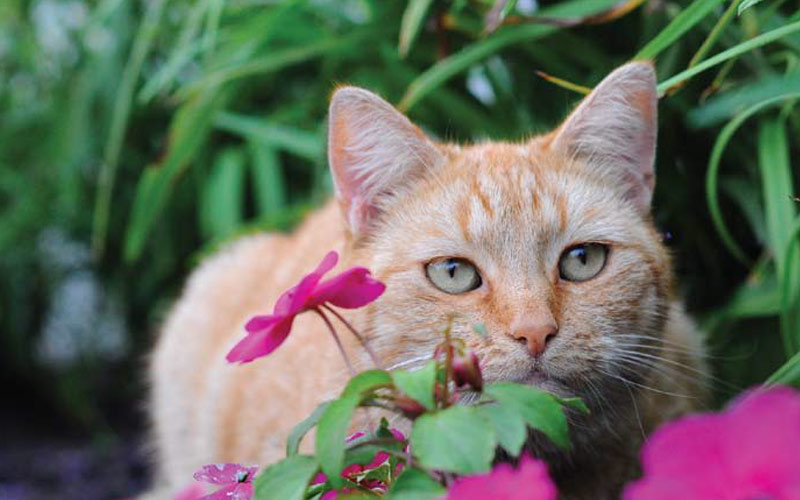Learn how to create a safe, attractive and stimulating outdoor haven for your cat.
Alot of my friends have cats, most of whom stay indoors 24/7. That’s fine for many felines, but I can’t imagine my kitty not being allowed to enjoy the great outdoors on a regular basis. It just seems so natural for a cat to be able to prowl through grass, chase insects, and roll on a sun-warmed patio stone, even if it’s just for half an hour a day.
Depending on where you live, there’s no reason your cat can’t go outdoors, as long as you create a safe environment that also offers him plenty of scope for physical and mental stimulation. A cat-friendly garden is the perfect setting for kitties who enjoy visiting the outside world from time to time. Here’s how to create one.
• While it’s fine for your cat to go outside, it’s not a good idea to let him roam at large. Train him to a harness and leash or consider cat fencing to surround your yard or garden. Purrfect Fence (purrfectfence.com), for example, offers fencing systems specifically designed to gently return your cat to the ground if he tries to climb over the top. They also help keep stray cats and other unwanted animals from entering your yard. Another alternative is to build your cat an enclosure – there are all kinds of configurations, sizes and styles to choose from. If you opt for a harness and leash, be prepared to stay with your cat while he’s outside. If you don’t have time to supervise his outings, cat fencing or an enclosure is the better way to go.
• Choose cat-friendly plantings for any beds or borders your cat is going to have access to. This means avoiding any toxic plants such as daylilies and Asian lilies, daffodils, clematis or hibiscus, and planting only non-harmful varieties like alyssum, bachelor’s button, impatiens, coreopsis, hollyhocks, roses, petunias, cosmos and many others. The ASPCA offers comprehensive listings of both toxic and non-toxic plants at aspca.org/pet-care/poison-control/plants.
• Also include plants that your feline will really like, such as catnip and various cat grasses. A variety of culinary herbs are good for kitties to nibble on too – these include parsley, dill, thyme, oregano and others. You can create a special herb bed just for your cat, or plant them in a container to place inside a cat enclosure or near his favorite sun-bathing spot.
• Do not use any chemical pesticides or fertilizers in the garden or on the lawn. They can make your cat ill.
• Cats love to climb, so your feline-friendly garden could include some small trees – tall enough to give him some exercise and fun, but not so large that he could get too high for comfort or use them as an escape route from your yard. Be sure to choose tree species that don’t grow thorns or drop poisonous fruit. If you don’t want to plant trees, and/or if your cat will be confined to an enclosure, use some logs or branches from fallen trees to make a simple “climbing frame”.
• Cats and wild birds don’t mix, so if you also want to attract birds to your yard, you’re going to have to find a way to keep them separated. A cat enclosure or supervised walks on a harness and leash are the best way to keep songbirds safe. Otherwise, situate bird feeders, bird houses and bird baths on another part of your property (e.g. a side or front yard) where your cat can’t go. Also avoid planting dense bushes or hedges near areas frequented by birds – cats love hiding in shrubbery to wait for unwary prey.
• Make sure the garden stays free of anything that could potentially harm your cat. Check the area regularly for wasp nests, remove any containers that might collect stagnant water, and ensure that sharp garden tools are put away. Avoid using cocoa mulch – it can be toxic if ingested.
• Ensure your cat always has access to fresh water and shade when he’s outdoors. Change the water on a daily basis. Do not leave cat food outside as it can attract strays, raccoons and other unwanted visitors.
• Watch the weather. Don’t take your cat outside for long periods when it’s wet, cold, or extremely hot and humid.
• Protect your cat from fleas, ticks and mosquitoes when he’s outside. Regular applications of beneficial nematodes can help rid your property of fleas and ticks. And although cats are most active at dawn and dusk, that’s when mosquitoes are also most active, so it’s best to keep your kitty indoors at those times. Long grass can harbor ticks and mosquitoes, especially if you live near fields, ponds or woods, so don’t let the lawn get too long before mowing it.
Check the area regularly for wasp nests,
remove any containers that might
collect stagnant water, and ensure that
sharp garden tools are put away.
• If coyotes are an issue in your locale, be extra vigilant. They can dig underneath fences, so stay with your cat when he’s outdoors, and never leave him out when you’re not at home. At the very least, provide him with a high place to escape to that’s well out of reach of dogs or coyotes.
There’s no reason why a cat-friendly garden has to be unattractive or sterile. There are all kinds of colourful flowering plants, trees, grasses and herbs that are safe for felines, and given today’s choices in cat enclosures and fencing, it’s much easier to keep your kitty from straying. This spring, why not factor your cat into your gardening plans?




No Comment